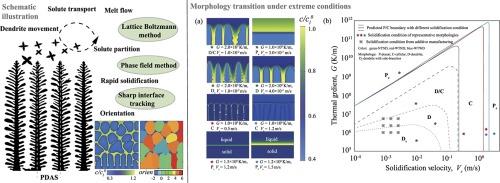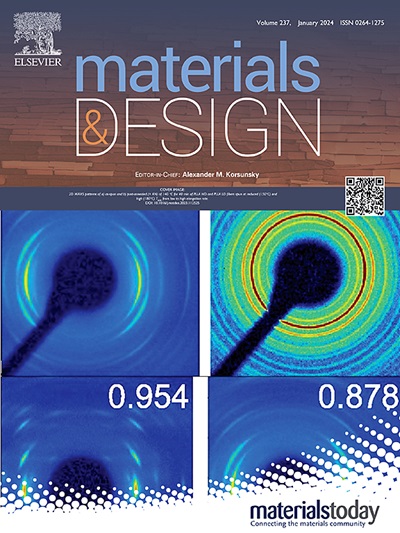A lattice Boltzmann model with sharp interface tracking for the motion and growth of dendrites in non-equilibrium solidification of alloys
IF 7.6
2区 材料科学
Q1 MATERIALS SCIENCE, MULTIDISCIPLINARY
引用次数: 0
Abstract
A lattice Boltzmann model (LBM) with sharp interface tracking is developed to simulate the motion and growth of dendrites in non-equilibrium solidification of alloys. The model is validated through comparative analysis with the drafting-kissing-tumbling (DKT) phenomena of two and three particles and the continuous growth model (CGM), and demonstrates its computational efficiency advantage without compromising accuracy by comparison with the multi-phase field (MPF) model. Subsequently, the model is utilized to investigate the dendrite morphology transition and primary dendritic arm spacing (PDAS). It is found that the velocity dependent solute partition and the resulting changes in constitutional undercooling strongly influence the estimated morphology region and PDAS. Moreover, the segregation and microstructure evolution during the rapid solidification were studied. And the results revealed that free dendrites lead to significant changes in microstructure and segregation under the influence of non-equilibrium effects. This work illustrates the great potential of the proposed model in simulating dendrites and microstructure evolution under a wide range of solidification conditions. Its suitability for extreme conditions and non-equilibrium solidification can contribute to the understanding of microstructure formation patterns and solute segregation in rapid solidification.

针对合金非平衡凝固过程中树枝状晶粒的运动和生长的尖锐界面跟踪晶格玻尔兹曼模型
建立了一个具有尖锐界面跟踪功能的晶格玻尔兹曼模型(LBM),用于模拟合金非平衡凝固过程中树枝状晶粒的运动和生长。通过与两个和三个颗粒的牵引-亲吻-翻滚(DKT)现象以及连续生长模型(CGM)的对比分析,验证了该模型,并通过与多相场(MPF)模型的对比,证明了该模型在不影响精度的前提下具有计算效率优势。随后,利用该模型研究了枝晶形态转变和主枝晶臂间距(PDAS)。研究发现,与速度相关的溶质分配和由此产生的制宪过冷变化对估计的形态区域和 PDAS 有很大影响。此外,还研究了快速凝固过程中的偏析和微观结构演变。结果表明,在非平衡效应的影响下,自由枝晶会导致微观结构和偏析发生显著变化。这项工作表明,所提出的模型在模拟各种凝固条件下的枝晶和微观结构演变方面具有巨大潜力。该模型适用于极端条件和非平衡凝固,有助于理解快速凝固过程中的微观结构形成模式和溶质偏析。
本文章由计算机程序翻译,如有差异,请以英文原文为准。
求助全文
约1分钟内获得全文
求助全文
来源期刊

Materials & Design
Engineering-Mechanical Engineering
CiteScore
14.30
自引率
7.10%
发文量
1028
审稿时长
85 days
期刊介绍:
Materials and Design is a multi-disciplinary journal that publishes original research reports, review articles, and express communications. The journal focuses on studying the structure and properties of inorganic and organic materials, advancements in synthesis, processing, characterization, and testing, the design of materials and engineering systems, and their applications in technology. It aims to bring together various aspects of materials science, engineering, physics, and chemistry.
The journal explores themes ranging from materials to design and aims to reveal the connections between natural and artificial materials, as well as experiment and modeling. Manuscripts submitted to Materials and Design should contain elements of discovery and surprise, as they often contribute new insights into the architecture and function of matter.
 求助内容:
求助内容: 应助结果提醒方式:
应助结果提醒方式:


